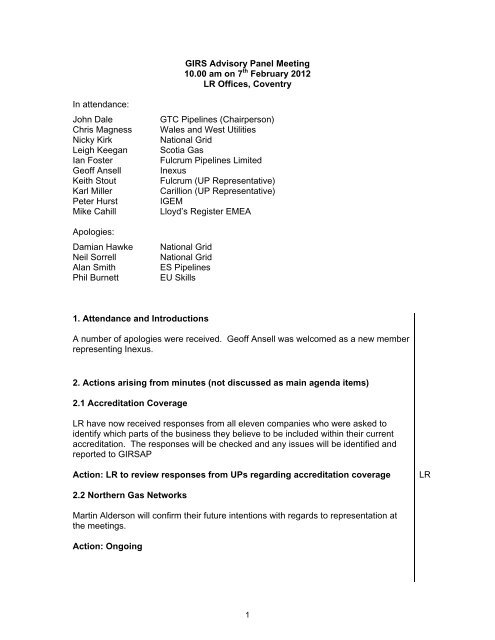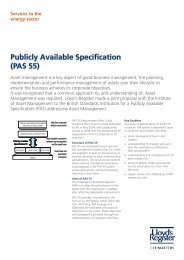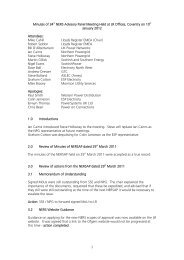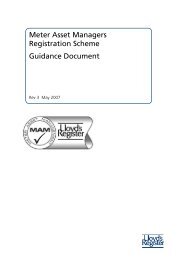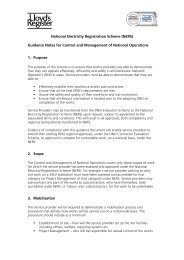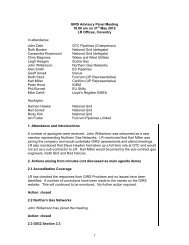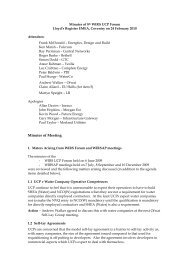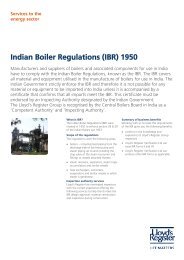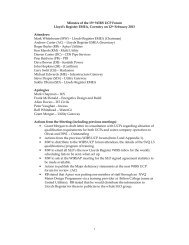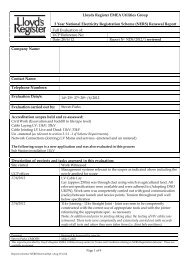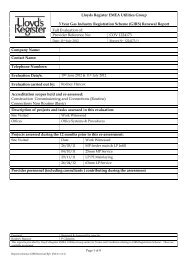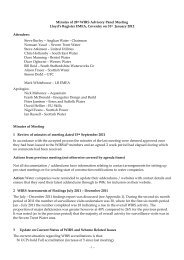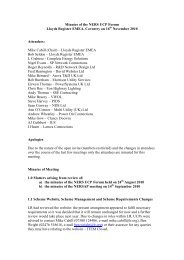GIRSAP Minutes 07-02-2012 - Lloyd's Register
GIRSAP Minutes 07-02-2012 - Lloyd's Register
GIRSAP Minutes 07-02-2012 - Lloyd's Register
Create successful ePaper yourself
Turn your PDF publications into a flip-book with our unique Google optimized e-Paper software.
GIRS Advisory Panel Meeting10.00 am on 7 th February <strong>2012</strong>LR Offices, CoventryIn attendance:John DaleChris MagnessNicky KirkLeigh KeeganIan FosterGeoff AnsellKeith StoutKarl MillerPeter HurstMike CahillApologies:Damian HawkeNeil SorrellAlan SmithPhil BurnettGTC Pipelines (Chairperson)Wales and West UtilitiesNational GridScotia GasFulcrum Pipelines LimitedInexusFulcrum (UP Representative)Carillion (UP Representative)IGEMLloyd’s <strong>Register</strong> EMEANational GridNational GridES PipelinesEU Skills1. Attendance and IntroductionsA number of apologies were received. Geoff Ansell was welcomed as a new memberrepresenting Inexus.2. Actions arising from minutes (not discussed as main agenda items)2.1 Accreditation CoverageLR have now received responses from all eleven companies who were asked toidentify which parts of the business they believe to be included within their currentaccreditation. The responses will be checked and any issues will be identified andreported to <strong>GIRSAP</strong>Action: LR to review responses from UPs regarding accreditation coverageLR2.2 Northern Gas NetworksMartin Alderson will confirm their future intentions with regards to representation atthe meetings.Action: Ongoing1
2.3 GIG2 Section 3.3The proposed changes to section 3.3 (CCCR) outlined at the last meeting wereagreed and these will be incorporated into the next revision of GIG2.Action: LR to amend GIG2 Section 3.3LR2.4 Working in Gaseous AtmospheresNo formal responses were received regarding the subject of gaseous escapes duringGIRS Provider works. Following further discussion there continues to be generalsupport for continued working where appropriate and on a risk-assessed basis.However, the circumstances are numerous and it is unlikely that GTs will wish torespond in detail regarding every eventuality. The general situation can best besummarised as follows.Gas escapes due to damage of the existing asset must be reported using theemergency gas escape route. Where there is a limited gas escape duringconnections works (situations previously discussed include: a drilling machine gateletting by and a leak being found on the service top tapping tee cap during a finalcheck with leakage detection fluid, LP service alterations and cuts offs where thediameter is 50mm steel or less and which are generally live gas operations notrequiring a RO under the SCO procedures) the GIRS Provider should consider thenature of the work, the extent of the gas escape, the risks involved, the competenceof the team and the arrangements in the method statement covering the work activityincluding assessing the risk involved and the use of breathing apparatus. Wherethere is any doubt regarding the content of the method statement the GIRS Providershould seek clarification from the GT prior to the works commencing and where thereis any doubt when a gas escape occurs then the work should stop and the GTcontacted.Action: GDNOs/iGTs to review the above summary statement and advise LR ofany specific issues. LR to issue the draft minutes to attendees and nonattendeesemphasising this minute.GDNs/iGTs2.5 SCO RenewalsThere is a new route for registration of SCO qualifications. Phil Burnett did not attendthe meeting and this will now be discussed at the next meeting.2.6 TD/3 membersIt is understood that the group has been established.Action: closed2
3. GIRS Providers Forum Feedback (items not already covered above or mainagenda item)3.1 Audit ScopeLR will consider providing clarification of the purpose of the audit scope in the nextrevision of GIG2. Reference to ISO 19011:20<strong>02</strong> needs to be amended to 2011version.Action: LR to amend GIG2 Section 3.7LR3.2 Competency SCO/STCThe discussion at the Forum regarding the GIRS Provider linking their competencyprocess to any existing SCO/STC processes to avoid duplication was reviewed. Themeeting did not raise any concerns with the proposal. It was agreed that theProviders competency process should provide suitable oversight and link all theelements that contribute to assessing competence, e.g. work observations,inspections, audits, interviews, qualification validity checks, etc.4. EU Skills – Design Qualification Option / NCO(G) QualificationThe initial proposed changes prepared by Phil Burnett had been circulated to<strong>GIRSAP</strong> and the GIRS Providers. Based on feedback received from one ProviderPhil had prepared revised proposals which were circulated to <strong>GIRSAP</strong> only prior tothe meeting.A full review of the proposals was undertaken. Whilst many of the proposed changeswere agreed others prompted much debate and the need for further changes. It isalso necessary to check some details with Phil to obtain a better understanding of theneed to change some of the existing words in GIG2. LR agreed to contact Phil andthen to propose further changes.The proposals will be incorporated in GIG2 in tracked format to allow <strong>GIRSAP</strong> to seethe new proposed text and the deletions.LR mentioned a preference for the GIRS Forum to have further opportunity tocomment on the proposals.Actions:LR to review the proposals with PB.LR to circulate draft amended GIG2 for comment prior to the next meeting.All to comment on proposalsLR/PBLRALL5. GDNO/iGT Changes Covering Technical / Process / Structure / Incidents /CommunicationsIt was agreed that efforts would be made to identify changes, incidents, etc. wherethere would be benefit in circulating information to the wider GIRS Providercommunity. LR would be willing to cascade information received. Information should3
e forwarded to Rachel.donaghy@lr.org6. Surveillance Visit FeedbackThe new format for the findings was presented. This was agreed as an improvementon the previous format and should enable more meaningful future discussion oftrends. The results for 2011 are shown in Appendix 1. The new items had beenadded. The requested improvements to text in the SV Deficiency Summary table andthe corrections in the Visits by Gas Company Areas table have been made in theattached version.7. Lloyd’s <strong>Register</strong> Progress ReportCurrent Statuses: Change from May 11− Full accreditation 48 (up 3)− Full with some scopes at Partial8 (no change)− Partial accreditation 11 (down 1)− Total 67 (up 2)− CNR(B) Full accreditation 18 (up 1)− CNR(B) Partial 2 (up 1)− UP’s under assessment12 (no change)− UPs accepted quotation since last meeting 2 (no change)8. New Gas Legislation and StandardsIGEM Standards updateStandards recently published.IGEM/TD/13 Edition 2 Pressure regulating installations for Natural Gas, LiquefiedPetroleum Gas and Liquefied Petroleum Gas/Air published in September 2011Seminars were held on 27 th October and 9 th February <strong>2012</strong>IGEM/UP/16 Design for Natural Gas installations on industrial and commercialpremises with respect to hazardous area classification and preparation of riskassessments published in October 2011.Seminar was held 20 th October.Standards in reviewIGEM/SR/29 Edition 2 Dealing with reported gas escapes – to be published in March<strong>2012</strong>.IGEM/G/1 Defining the end of the network – to be published April <strong>2012</strong>IGEM/G/5 Ed 2 Gas installations in flats and other multi-dwelling buildings – to bepublished in April <strong>2012</strong>Standards to be reviewed in <strong>2012</strong>IGE/TD/3 Ed 4 Steel and PE pipelines for gas distributionIGE/TD/4 Ed 4 PE and steel gas services and service pipework4
IGEM/GM/7B Hazard area classification for gas metering equipmentIGE/GL/1 Ed 2 Planning of gas distribution systems of MOP not exceeding 16 barIGE/GL/2 Ed 2 Planning of transmission and storage systems operating at pressuresexceeding 16 barIGE/GL/8 Ed 2 Reporting and investigating gas related incidents.9. AOB9.1 GIG2 References to StandardsPeter Hurst has proposed amendments to the GIG2 reference library which LR willincorporate into the next revision.10.1 Amendments to the reference library.• Energy Utility Skills Competency guidance• GIG/2• IGEM/TD/101• IGE/TD/3, TD//4 and TD/13 as appropriate IGE/TD/4 and IGEM/TD/13 asappropriate• IGE/TD/3 Supplement 1 IGEM/G/8 as appropriate• IGE/GM/8 as appropriate• IGE/GL/1, GL/2, GL/4, GL/5, GL/6 and GL/8 as appropriate• IGE/SR/18, IGEM/SR/25, SR/26 and IGEM/SR/28 as appropriate• IGE/G/5• IGEM/GL/4 - Gas system assets - risk management• BSI 6400 - 1 and BSI 6400 - 2 as appropriate• Gas Act, HSWA, NRSWA and Environmental Protection Act (EPA)• Pipeline Safety Regulations (PSR) and Gas Safety (Management) Regulations(GS(M)R)• HS(G)47• The Gas Safety (Installation and Use) Regulations 1998 (GS(I&U)R)• Material Specifications5
• New Roads and Streetworks Act• NJUG Guidance• NJUG Specifications for Reinstatement of Openings in HighwayAction: LR to update GIG2 Section 10.110. Next MeetingOutstanding <strong>2012</strong> gas meeting dates are as follows.GIRS Forum – 15 May, 4 September<strong>GIRSAP</strong> – 31 May, 25 September6
Appendix 1 - GIRS Assessment Visit Findings Summary ReportFor 1 January to 31 December - 2011This report summarises the findings from surveillance visit assessments ofcompanies holding GIRS accreditation. It separately identifies findings relatingto office systems and field activities.Surveillance VisitsDuring the 12 month period 1 st January through to 31 st December June 2011- 67 surveillance visits were carried out on the 45 UPs holding ongoingGIRS accreditation- These visits resulted in 14 major deficiencies being identified and 58 minordeficiencies being identifiedThe actual findings are detailed in the table in the report.Major deficiencies being where immediate rectification action is required withminor deficiencies being where the remedial action needs to be completed beforethe next visit.The 72 deficiencies identified equates to around 1 per visit. These aresummarised in the charts in the report. The total number of deficiencies raisedper visit in 2011 (72 in 67) is similar to 2010 (74 in 70) however the number ofmajor deficiencies (14 in 2011 compared to 8 in 2010) has significantly increased,although there has been some re-alignment of the baseline and previously someof the major deficiencies, particularly relating to competence, could have beenclassified as minor deficiencies.GIRS SV Deficiency Summary4%6% 6% 17%Gas Company Interface28%39%CompetencyWork ControlsMethod of WorkingSubcontractorsTechnical Auditing Controls7
The detailed breakdown of deficiencies being provided in the following tableGIRS Deficiency Report SummaryIdentified Deficiency2011 (FullYear) Jan-Jun <strong>2012</strong>Major Minor Major MinorGas Company InterfacesNotices and agreements not in place before work start 0 1Completion files missing data or sent late 1 1CompetencyDesign not undertaken/approved by qualified designer/approver 0 0Competency Assessments Not Complete or Up to Date 1 3Assistant not registered (or out of date) with EUSR 2 0Utility SHEA (Gas) out of date 1 0EUSR Cards not available for operative on site 0 0Technical Advisor role not adequately defined 0 1Induction (incl subcontractors) inadequate 0 2Company ID Card out of date/not available on site 0 2Work ControlsDesign process inadequate 1 1Design not to standards 1 0Material specifications not up-to-date 0 1Work specification (incl drawings) is inadequate 1 10Work specification to developer & groundworkers inadequate 0 0Inadequate controls when site not ready 0 0Method statements/policy docs out of date or not signed off 1 5Method statements held do not fully cover all work activities 1 6Risk assessments out of date 1 0Errors/inaccuracies in method statements/risk assessments 0 0COSHH Sheets do not cover all substances 0 0Adequate briefings not provided to all staff 0 0Method of WorkingWork not being done fully to required standards 1 10Materials being used precludes correct methods of working 0 0Equipment being used precludes correct methods of working 0 2Equipment defective/not in calibration 0 1Material not adequately checked on site 0 2Fittings not adequately stored 0 2Appropriate PPE not available 0 2SubcontractorsWork processes do not adequately check subcontractors 1 0Work controls do not adequately control private service laying 0 3Technical Auditing ControlsAudit programme inadequate/does not cover all work activities 1 3Audit findings not adequately followed up 0 0Totals 14 58 0 0Percentage of Totals 19.4% 80.6% #DIV/0! #DIV/0!8
35GIRS SV Deficiency Summary2011Jan-Jun <strong>2012</strong>30No of deficiencies2520151050Gas Company InterfaceCompetencyWork ControlsMethod of WorkingSubcontractorsTechnical Auditing ControlsVisits by Gas Company Areas (Jan-Jun <strong>2012</strong>)No of Visits10.90.80.70.60.50.40.30.20.10National GridScotia GasNorthern Gas NetworksWales & WestFulcrumGTCInexusESPBritish Gas PipelinesSSE PipelinesEnergeticsNon Company Specific (Design)9
Full details of the actual findings are given below. (Duplicates are combined with thenumber of occurrences indicated).‘O’ indicates deficiency identified during office/system evaluation and ‘F’ indicates deficiencyidentified during field based assessmentGas Company InterfacesMajor(O) Outstanding completion files (x2)Minor(F) GT approval not in construction packCompetencyMajor(F) Competency procedure does not specify frequency or forms to be used(F) Assistant not EUSR registered(F) Team do not have SHEA gas cards(O) Design assistants STC does not define limits of competencyMinor(O) No competency assessments undertaken on Technical Advisors(O) Competency reviews not completed to procedure(F) GN01 card not available on site(F) Company ID cards not on site (x2)(F) interview records not available for new starters (x2)(F) Competency reviews do not include detailed evidenceWork ControlMajor(F) Risk management procedure has no mention of GIRS as per GIG 2.2(F) No evidence of which risk assessments are issued in team pack(F) No variations drawings(F) Design drawing does not show all details, i.e. connection + ECV terminations(O) Design procedure does not include design blocksMinor(O) Design drawing – no details for ECV or on meter room ventilation requirements(O) Design pack does not contain note re-load cannot be taken until NG networkreinforced(F) H&S policy documents not in vehicle(F) Service laying method statement does not detail connections to metallic mains(F) Work instruction refers to previous owners method statement(F) Corrosion protection of steel valves, etc. not addressed in method statement (x3)(F) Method statement does not have test pressures or duration of test(F) Discharge of static electricity on PE pipe not referenced in method statement10
(O) Drawings do not have details on non domestic service terminations, ECV details andminimum length of laterals(F) No safety and quality pack issued to team(F) Numerous deficiencies in method statements, MP service laying, termination ofservices >63mm dia., moling operations, pressure testing at pressures . 2bar(F) Method statements to be reviewed, definition of non-routine operations, MP servicelaying, removal of references to Transco(F) Service laying method statement does not detail MP service proximity / distances forvent pipes(F) Method statement not available for connections to metallic mains inserted with PE(F) Gas design drawing not on site(F) Service laying method statement dated 20<strong>07</strong>(F) Not all services on design drawing(F) Method statement requires update re – fitting clamp and rotating coupler(F) Review of method statements to be signed by Technical Advisor(F) Variation procedure to be updated(F) Material specifications not up-to-dateMethods of WorkingMajor(F) Height of ECV does not conform to IGE/TD4Minor(F) Pipe rollers not on site(F) Eyewash not on site(F) Whilst purging services – no flame trap, no fire extinguisher, no assistant(F) Service not perpendicular to main(F) Material specs not on site (x2)(F) No main under test sign available(F) Marker tape on road crossing on top of pipe(F) Service with only 200mm cover(F) Main in verge with only 650mm cover(F) No stabilisation time observed after initial pressurisation(F) No service testing of ECV carried out(F) Polythene fittings not in bags (x2)(F) Clamp not used on spigot of PE Tee due to lack of space(F) Cable locator beyond calibration due date(F) Tee connection undertaken instead of end-on connection(F) Marker tape missing on part of service(F) Fire extinguisher without calibration dateSubcontractorsMajor(F) Information provided to developers on marker tape inadequateMinor(F) No evidence available to demonstrate compliance with GIG2 section 511
(F) No service marker tape laid by developerTechnical Auditing StandardsMajor(O) Audit programme does not include external audits of designs carried out by designerMinor(O) Some monthly audits not available(O) Low level of technical audit by Technical Advisor(O) Subcontractor method statements for service laying to include marker tape(O) Subcontractors to be monitored to ensure that top tapping tee clamps are tested12


